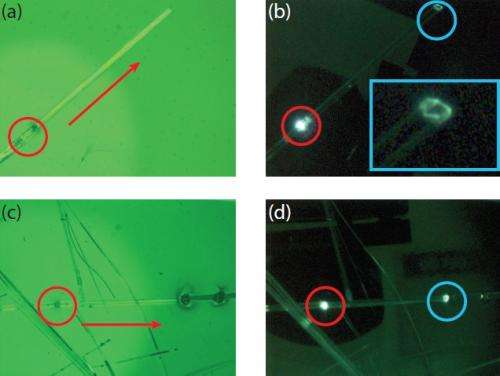Surprise: Biological microstructures light up after heating

Physicists from Radboud University investigated tubular biological microstructures that showed unexpected luminescence after heating. Their findings were published in Small on July 29. Optical properties of bioinspired peptides, like the ones investigated, could be useful for applications in optical fibers, biolasers and future quantum computers.
The luminous peptide microstructures self-assemble in a water environment. After heating them with a laser, they showed luminescence in the green range of the optical spectrum (Figure 1).
Surprising luminescence
Physicist Sergey Semin from Radboud University explains: 'The optical activity in the green range was a surprise for us. According to our theories, the molecular structure of our molecules forbids them to be luminescent in that spectral range. We expect that interactions between the peptide and the water molecules might be the cause for our unexpected finding. They form a kind of 'super cell' together, which we hypothesize emits light after heating.'
Biological structures with physical properties
'In general, it's very interesting that biological structures like the ones we studied show physical properties like luminescence', says Semin. Understanding the underlying mechanisms can give new insight in the optical properties of peptides and short organic molecules. That could lead to applications like optical fibers for data transfer, biolasers or applications in future quantum computers.
Recognizing brain plaques
Another interesting application might be in the biomedical field, since the microstructures are the core recognition motif of β-amyloid fibrils that form plaques in the human brain and lead to Alzheimer's and some other brain diseases. The recognition structures can be excited and made visible by heating them, but clinical applications are still far away. Semin: 'The more we know about such structures, the more we can do for diagnosis and treatment.'
Semin works at the Spectroscopy of solids and interfaces department, in the research group of prof. Theo Rasing.
More information: Semin, S., van Etteger, A., Cattaneo, L., Amdursky, N., Kulyuk, L., Lavrov, S., Sigov, A., Mishina, E., Rosenman, G. and Rasing, Th. (2014), "Strong Thermo-Induced Single And Two-Photon Green Luminescence In Self-Organized Peptide Microtubes." Small. DOI: 10.1002/smll.201401602
Journal information: Small
Provided by Radboud University Nijmegen




















